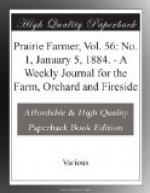There ought to be great satisfaction among the wearers of bonnets and hats this season, because they can so easily have what they want—big or little, plain or decorated, as they please. For a person with dark hair, gold braid loosely put around the edge of a velvet capote is very becoming. Bunches of tips are worn much more than the long, drooping plumes, though both are fashionable; while birds—sometimes as many as three on a hat—are often preferred to either. We notice upon the street a great many elegantly dressed ladies with but a single band of wide velvet ribbon fastened somewhat carelessly around the bonnet and tied in a bow under the chin. Unique it may be, but undoubtedly the taste of the wearer, would be the verdict of the passer by. In fact, one can scarcely be out of the fashion in the choice of a bonnet or hat, but care should be taken that it be just the thing for the wearer, and that it be properly put on.
I firmly believe in the doctrine that “good clothes tendeth toward grace.” What woman can not talk better when she knows she looks well? She can then forget herself and lose all self-consciousness, which is a state most devoutly to be desired by all women—particularly our young women. So, girls, study your costumes, especially the “superfluities,” or “furbelows,” as they are wont to be called; make yourselves look as pretty as you possibly can—and then forget yourselves.
I wish all our lady readers might have been here the holiday week, for the stores were perfect bowers of beauty. It was a pretty sight in itself to watch the crowds of happy-faced children, with their little pocket-books in their hands, at the various counters buying presents for father, mother, brothers, and sisters. Children always enjoy Christmas more when they can make, as well as receive, presents. So I hope all our little readers were made happy by both giving and receiving.
I am sorry I could not give you a more satisfactory talk on the fashions, but our space is limited this week. I hope the ladies will not forget that our “Household” department is open to them, and that they will contribute anything that may be of interest to the others.
MARY HOWE.
A KITCHEN SILO.
The farmer’s wife in the Netherlands has long been using a sort of a silo. Probably she had been doing so for long years before M. Geoffrey began experimenting with preserved stock food in France. The Netherland housewife’s silo consists of an earthenware jar about two feet tall. Into one of these jars in summer time she places the kidney bean; in another shelled green peas; in another broad beans, and so on. Making a layer about six inches deep in each. She sprinkles a little salt on top and presses the whole firmly down. Then she adds another layer and more salt. She leaves a light weight on top to keep all well pressed down and exclude the air, in the intervals between pickings for often the harvest of a single day will not fill the jar. When full, she puts on a heavier weight, and covers all with brown paper. She thus has green vegetables preserved for winter. The ensilage is said to be “more or less good, according to taste.”




